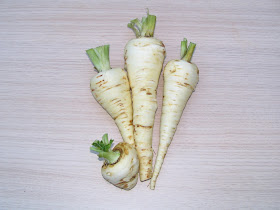At this time of year, many gardeners in the UK will have Red Cabbages ready for harvesting. This type of cabbage, whilst being nice enough, is less "flexible" in the kitchen than the green or white types. One way of eating it that is popular in the UK is braised (slow cooked in the oven, often with some apples or raisins added to sweeten it). This is traditionally served as an accompaniment to the well-known dish Lancashire Hotpot (slow-cooked lamb with onions, potatoes etc). However, Jane has given me a really easy recipe for pickled Red Cabbage, which will enable you to keep on enjoying this vegetable for many weeks after harvesting it.
 |
| Pickled Red Cabbage |
Easy Pickled Red Cabbage
Pickled red cabbage is very easy to make, especially if you keep some ready-spiced pickling vinegar, such as Sarsons, in stock. A whole red cabbage will make 4 - 6 jars of pickle, but this recipe is so easy that if you have spiced vinegar to-hand it is worth using even a small (perhaps left-over) piece of cabbage to make a single jar.
If you don't have any pickling vinegar in stock, you need to prepare some. This is how you do it:- put a bottle of malt vinegar in a pan with either a sachet of pickling spice or a muslin bag (or J-cloth tied with string) containing your preferred combination of dried chillies, peppercorns, bay leaves, cloves, coriander seeds, sliced dry ginger, a cinnamon stick and mustard seeds. Heat until just boiling, remove from the heat and leave until completely cold and remove the bag of spices. The vinegar is then best left to infuse overnight, while the cabbage is salting.
Prepare the cabbage by shredding it as finely as you can - a food processor or mandoline is ideal - (but if you use a mandoline PLEASE use a finger guard!). Put it into a large non-metallic bowl, layering it with lots of salt - at least 100g for a whole cabbage - and mix together so that all the shreds are coated in salt. Cover tightly with clingfilm and leave it to stand overnight.
Next day, rinse off all the salt - filling the bowl with water and draining a few times will dissolve it - then drain in a non-metallic sieve, pressing well to remove all the water. The cabbage will at this stage be a very unappetising colour of blue.
Pack the cabbage as tightly as you can into cold, sterilised jars, then pour in the vinegar to completely cover the cabbage, turning the jars and prodding (a wooden satay stick is ideal) to remove air bubbles so that the vinegar reaches every bit of cabbage. The colour will immediately begin to turn back to red.
Check that the insides of the jar lids have a plastic coating rather than metal (which can corrode if it comes into contact with vinegar) - if they don't, put a layer of clingfilm over the top before putting the lid on. Seal tightly.
Most pickles need time to mature but you can start eating red cabbage after only a week and it is best within a couple of months of being made. It will keep much longer than that if it has to, but starts to go soggy and will not be at its best.
Serve with cold meats and cheese... or with pork pies... or with pasties... or meat-and-potato pies... or...
Here are some more photos...
Even if Red Cabbage was not nice to eat, you'd grow it for its ornamental value wouldn't you? Do you think each one is unique, like the finger-print???






















































